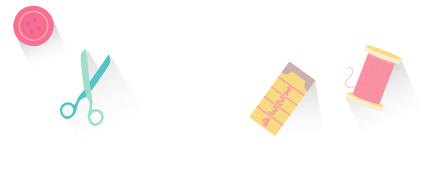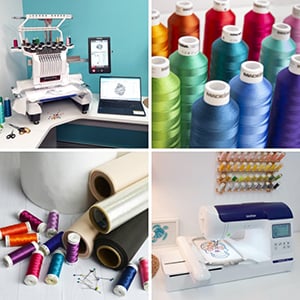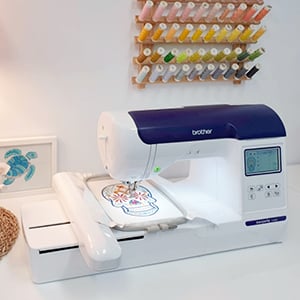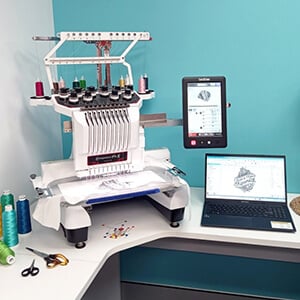Categories
Pricing Your Services in your Home Embroidery Business
A Comprehensive Guide: Pricing Your Services in your Home Embroidery Business

Starting a home embroidery business can be an exciting and creative venture. You have the opportunity to transform your passion for embroidery into a profitable business. However, one of the most critical aspects of running any business is determining how to price your services. Pricing can make or break your home embroidery business, and it's essential to get it right to ensure both customer satisfaction and business sustainability.
In this article, we’ll cover the key factors to consider when pricing your embroidery services, including costs, market research, value perception, and pricing strategies.
1. Understanding Your Costs
The first step in setting prices for your embroidery business is understanding your costs. These can be divided into two categories: fixed costs and variable costs.
a. Fixed Costs
Fixed costs remain consistent regardless of how much work you do. For a home-based embroidery business, these could include:
Embroidery machine(s): The cost of purchasing or maintaining your embroidery machine.
Software and technology: Embroidery design software, computer maintenance, and other essential technology.
Rent or mortgage: Even if you work from home, a portion of your housing costs may be allocated as business expenses.
Utilities: Electricity, water, and internet that support your business operations.
Insurance: Depending on the scope of your business, you might need liability or business insurance.
Licensing and taxes: Costs of any business licenses and relevant taxes.
b. Variable Costs
Variable costs change depending on the size and number of orders. These might include:
Materials: Thread, fabric, stabilizers, needles, and backing materials.
Time and labor: Your time is a valuable resource. Consider the hours spent on designing, stitching, and finishing each project.
Shipping and packaging: The costs associated with shipping finished items to customers and packaging materials.
Understanding both fixed and variable costs gives you a clear picture of how much it costs to run your business and will guide you in setting a price that covers these expenses.
2. Assessing the Market
Market research is essential in determining how to price your embroidery services. Knowing what your competitors charge and understanding customer expectations in your niche can give you valuable insights.
a. Research Competitors
Identify other embroidery businesses in your area or online. Check out their websites or social media profiles to see how they price similar products or services. Pay attention to whether they charge by design complexity, stitch count, or the type of garment. Take note of their pricing models, including any discounts or package deals.
b. Analyze Customer Expectations
Your target customers will likely have different price expectations based on the type of embroidery service they seek. Are you targeting individuals looking for custom gifts, or are you working with corporate clients seeking branded apparel? Pricing expectations for small, personalized items will be very different from bulk orders of corporate logos on uniforms.
c. Identify Gaps in the Market
In your research, you may find gaps in the market that your business can fill. For example, you might offer more affordable options than luxury embroiderers or more personalized services than mass-market companies. This can inform how you price your services to appeal to a specific customer segment.
3. Value Perception and Quality
The price you set sends a message to your customers about the quality of your work. If you price your services too low, potential clients may assume that your work is of low quality. On the other hand, pricing too high without delivering exceptional value can alienate your customers. The key is to balance price with perceived value.
a. Showcase Your Expertise
If you have years of experience, specialized skills, or unique design capabilities, make sure to emphasize these qualities when promoting your services. Customers are often willing to pay more for skilled craftsmanship and high-quality materials.
b. Create Packages
Offering service packages can increase the perceived value of your embroidery. For example, you can create packages that include consultation, design, and finishing touches. Bundle services to give customers a reason to invest more while simplifying their decision-making process.
4. Pricing Models
There are various ways to price your embroidery services. Choosing the right pricing model depends on the type of work you do and the preferences of your target audience. Let’s explore some common pricing methods.
a. Hourly Rate
This is a straightforward approach where you charge based on the time spent on each project. To calculate your hourly rate, consider how much you want to earn annually, and divide that by the number of hours you plan to work in a year. For example, if you want to earn $50,000 per year and plan to work 1,000 hours, your hourly rate would be $50.
b. Cost-Plus Pricing
This method involves calculating the cost of materials and adding a markup for profit. If the material cost for a project is $10 and you apply a 50% markup, you would charge $15 for that project. This is a common method for pricing tangible goods, but it doesn’t always account for labor time effectively.
c. Stitch Count Pricing
Some embroidery businesses charge based on the number of stitches in a design. For example, you may charge $1 per 1,000 stitches. This pricing model is popular because it accounts for the complexity of the design and how long it takes to embroider.
d. Flat Rate Per Item
You may choose to charge a flat rate per embroidered item, regardless of the design complexity. This model is simple and works well for standardized items, such as monogramming towels or embroidering company logos on polo shirts.
e. Tiered Pricing
You can create different pricing tiers based on design complexity, size, or the type of item being embroidered. For example, you may charge a lower rate for simple monograms and a higher rate for intricate, custom designs. This allows you to cater to a broader range of customers with varying budgets.

5. Adjusting Prices Over Time
Your pricing structure isn’t set in stone. As your business grows and your skills improve, you may need to adjust your prices to reflect increased demand or higher costs.
a. Factor in Inflation and Material Costs
Keep an eye on rising costs for materials, utilities, and other expenses. You may need to periodically raise your prices to account for these changes.
b. Offer Promotions Carefully
While discounts can attract customers, be cautious about offering too many promotions. Constant discounts can devalue your work and lower customer expectations regarding pricing.
c. Review Competitor Prices Regularly
The market may shift over time, so it’s important to regularly review what your competitors are charging and adjust your prices if necessary.
Conclusion
Setting the right price for your home embroidery business requires a balance of understanding your costs, conducting market research, and considering the perceived value of your services. By choosing a pricing model that aligns with your business goals and continuously reviewing your prices, you can ensure that your embroidery business remains profitable while delivering quality to your customers.
Visit the Hatch Home Business Hub for more information and to request the FREE eBook.
The definitive choice when selecting embroidery software for your home embroidery business.
Hatch Embroidery software is a comprehensive embroidery design solution that offers a range of tools and features for both beginners and seasoned embroiderers.
Here’s why it's a great choice for your business:
- User-Friendly Interface: The software is designed with a user-friendly interface that makes it easy for anyone to start creating beautiful embroidery designs, regardless of their experience level.
- Powerful Editing Tools: It provides powerful editing tools that allow users to resize, edit, and adjust embroidery designs with precision. This is essential for businesses that need to customize designs according to specific customer requirements.
- Wide Range of Formats Supported: Hatch Embroidery supports a wide range of machine file formats, making it versatile for use with different embroidery machines. This flexibility is crucial for businesses operating with multiple machine types.
- Professional Quality: The software generates professional-quality stitches, ensuring that the end products are of high quality, which is vital for maintaining customer satisfaction and business reputation.
- Extensive Design Features: With features like auto-digitizing, lettering, monogramming, and even special effects, businesses can offer a wide range of embroidery services, increasing their market appeal and potential revenue streams.
- Regular Updates and Support: Hatch provides regular software updates and robust customer support, ensuring that businesses can always access the latest features and get help when needed.
Overall, Hatch Embroidery software equips your business with the tools necessary to create stunning, high-quality embroidery designs efficiently and effectively, enhancing productivity and customer satisfaction, making it pivotal when selecting suppliers and supplies for your home embroidery business.
Hatch Embroidery software products are in popular use in over 120 countries. It is time to join the global trend and give Hatch a try! The 30-Day Free Trial grants you unlimited use of all the amazing features and the 30-Day Money-Back Guarantee ensures that there is absolutely no risk involved. In fact, choosing Hatch Embroidery software is one of the smartest things you can do when selecting suppliers and supplies for your home embroidery business.
Enjoy over 200 FREE lessons presented by our own embroidery experts in Hatch Academy. Grow your confidence and embroidery skills fast to start creating your own beautiful designs in no time!








